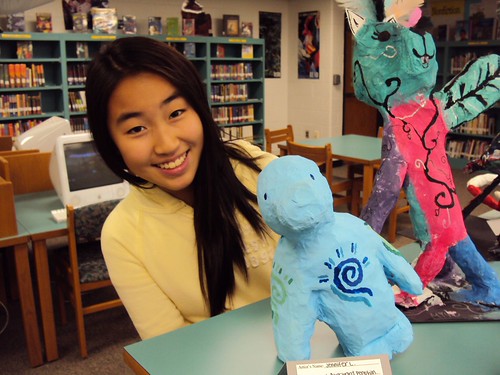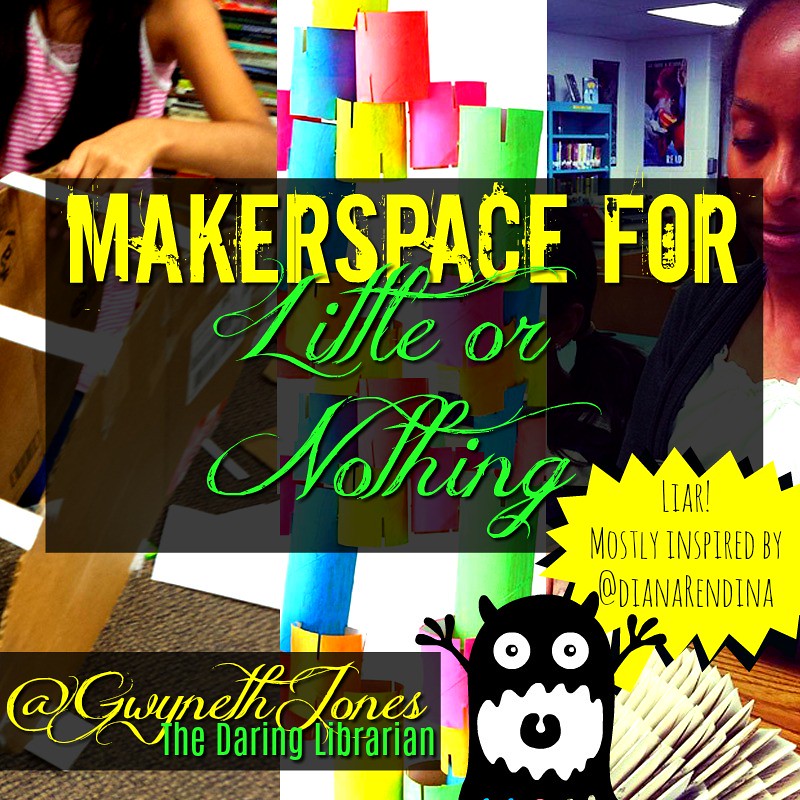
Makerspace for Little or Nothing
You don’t have to spend thousands of dollars to start a Makerspace area.
You don’t have to have a designated room or rip out bookcases.
You don’t have to make a Lego wall or buy a 3-D printer!
You can even have a Makerspace on a cart!
When we have testing in our Library, I put all our Makerspace stuff on an AV cart and roll it into our server
room. This post evolved from a previous post called Makerspace Starter Kit Updated on my professional blog where I had some of these idea, but I felt that it deserved it’s own expanded post.
You can take baby steps into the Maker Movement. I’ve been saying that for 7 years or so….long before I blogged about it, I tried it out.
A Makerspace is what you make of it!
Big or small, lavish or little, it’s all about the maker mindset. Constructivism. Be creative! Be crafty! Ask your kids what they want and brainstorm how to bring it to the school! Ask for donations. Ask for help. Don’t worry if it’s not perfect at first or if you fail. Just give it a shot.
TP & Paper Towel Building Blocks
Collect toilet and paper towel rolls, heck – have the whole school collect them! Say you’re trying for 50 or 100 – put a decorated cardboard box outside your Library or Classroom for donations!
Make sure to Tweet, IG out, or add the request to your staff & community newsletter! But be careful, you could get an AVALANCHE of materials!
Then cut them into different lengths, have the kiddos paint them with water based paints and notch them with scissors — then let kids build with them! Store them in milk crates or bins. Voila!
I’ve heard lately, that some people don’t like this idea because they’re concerned about germs. I guess TP rolls & airborne germs? I’m kind of a germophobe, and I didn’t even think about that! Sheesh. How about lightly spraying all the cardboard rolls with Lysol? OR..how about using paper towel rolls cut into different lengths? More! Cardboard Tube STEM Activities and more! This is a Mommy blog that has lots of great STEM ideas! W00t!
Origami Makerspace Pinterest Board.
Origami is the perfect addition to a Maker program. Gather some origami books (I have like at least 10) paper of all kinds, safety scissors, rulers, and a recycling bin or the scraps and Voila! Kids love folding paper and even though I’m not patient enough to do this myself, many of my kiddos are amazing at Origami!
Great Introductory Origami Projects:
|
+
|
+
|
+
|
from:
Paper Folding/Origami – MIT Edgerton Center – K12 Makerspaces
LEGOS for Nothing.
Here’s Sam, who generously donated these LEGO pieces!
Here’s the super cool Cassius, who does smile, I swear! Giving us like two big tubs of great LEGO pieces! Such a great kids!
My lovely wonderful Library Media assistant Kathi, took them home over the weekend and put them all in a bucket with a bleach solution & dried them in the sunshine. Voila! Just like new!
Ask your PTA, ask your kids, have a LEGO donation bucket by the door of your Library Media Center or classroom and check out yard sales and thrift shops. Bleach is amazing and cheap. Go for it!
Now… I’ve totally snagged (with permission!) some amazing ideas from MY Makerspace Guru, Diana Rendina!
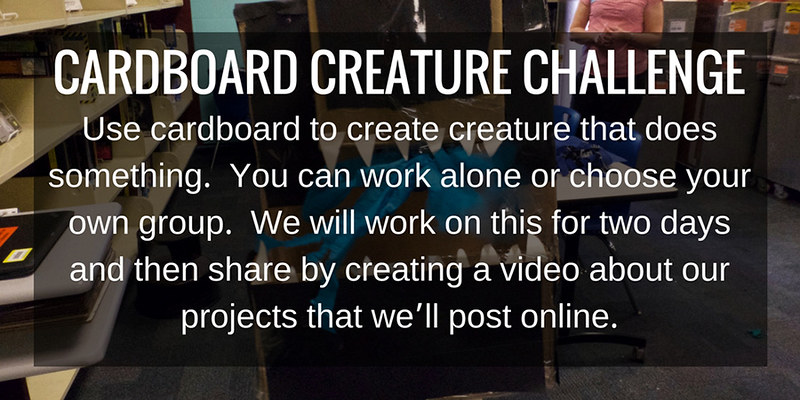 |
| Graphic by @DianaLRendina |
Cardboard Creature Challenge
Now, shamelessly stolen from my Makerspace Gur, Diana Rendina – Teasing Excerpts from the amazing article she wrote for Demco titled 3 Design Challenges for the Low-tech Makerspace (Link below – I promise! Just don’t want to lose you quite yet, you may never come back!;-)
“The Cardboard Challenge has long been one of my favorite makerspace activities. Inspired by the amazing short film Caine’s Arcade and the Imagination Foundation’s Global Cardboard Challenge (October 6th – Join in!), I create a new variation on this challenge every year. We’ve created cardboard arcades, robots, buildings, etc.” — Read the article for more!
 |
| Graphic by @DianaLRendina |
Tech Take-Apart Robot Challenge
Tech take-apart is a classic makerspace activity. This design challenge
takes it a step further by recycling the technology into a robot made by
students. This project doesn’t have to be super complex — picture a
shoebox painted with black paint that has keyboard keys and circuit
boards glued to it. (link below – I promise!)
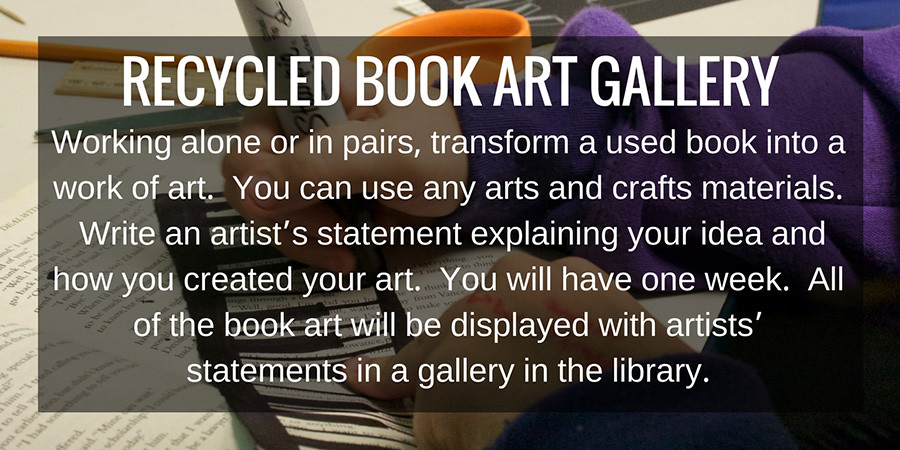 |
| Graphic by @DianaLRendina |
Recycled Book Art Gallery
Our Art Teacher does this and we always love to provide gallery and brainstorming space! Maybe she gets some of our weeded books OR maybe she uses donated books from the kids and
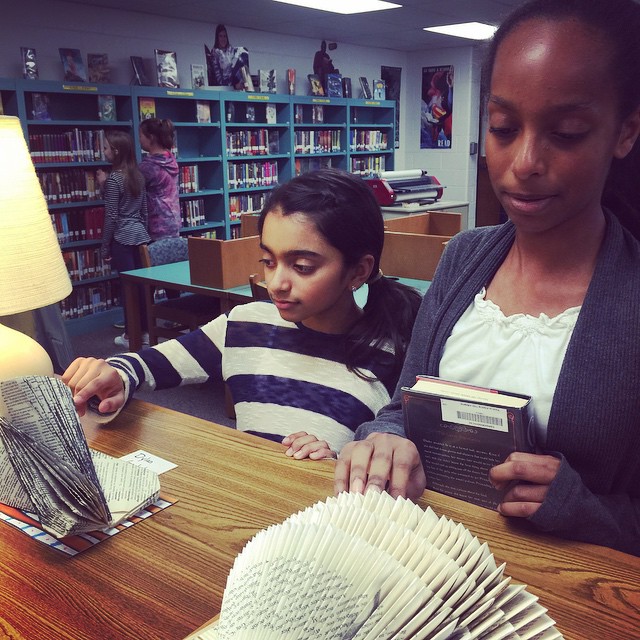 |
| MHMS Upcycled Book Art Gallery Walk from my IG |
the community. I can’t speak to that here… my supervisor might see this!
Here’s what Diana has to say about this!
“We all have damaged or out-of-date books that we’ve weeded from our library. Instead of tossing them out, why not transform them into recycled art? Browse Pinterest or check out some of the recommended resources below to gather inspiration for students. Provide students with a variety of arts and crafts supplies, including glue, tape, paint, scissors, glitter, etc. Teach the students about what an artist’s statement is, and have them write one up once their project is done. Then create a gallery of all the students’ projects in the library and invite classes to visit for a gallery walk. This is a great way to introduce students to the world of professional art and a fantastic way to recognize their work. Design prompt: Working alone or in pairs, transform a used book into a work of art. You can use any arts and crafts materials, including paint, scissors, glue, tape, etc. Write an artist’s statement explaining how you came up with your idea and how you created your art. You will have one week to complete the project. All of the book art will be displayed with artists’ statements in a gallery in the library. ”
by Diana Rendina
She makes my Makerspace look like small potatoes or tater tots! I admire all she does and in a perfect world, I would totally adapt more of her ideas and projects. BEHOLD and admire!
5 Questions to ask when planning a Makerspace
By Diana Rendina
Are you the type of person who likes to fill in worksheets? Click here to download a FREE printable 5 Questions worksheet!
More from my Makerspace Guru, Diana Rendina:
How to Start a Makerspace When You’re Broke
Starting a Makerspace: Baby steps
3 Design Challenges for the Low-tech Makerspace
Or just search her blog for all her posts on the Maker Movement, buy her books, and be sure to follow her on Twitter! Diana Rendina (@DianaLRendina) she’s kind of amazing.
Don’t forget that video production, animation, green screen, blue screen, TV studio, coding, programming, any collaborating with a Science class can make your school Makerspace program shine! Make sure to bring in other subject areas. Don’t just have a Maker program in the Library, have the Maker mindset all over the school. Work with your Tech Ed teacher, FACS (what was once called Home Economics) and Art teacher. Make your Library a great space to display artwork. I’m a big advocate of STEAM rather than STEM. Think about gallery openings and gallery walks. This gets more people into your space.
Consider creating short videos on Instagram or YouTube having kids talk about their artwork & create a QR code to that post that you print out and put next to the artwork. That way, when people see the display, they can scan and see the video.
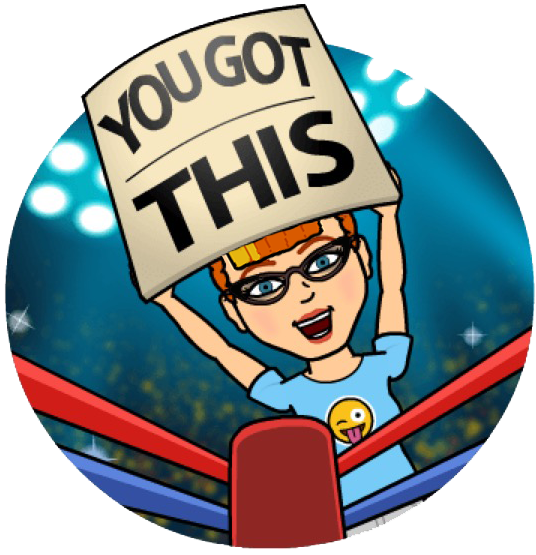 Do NOT let the expense, mess, trouble, or obstacles stop you from doing this! Be the innovator and the spark in your school or district. You got this! I know you can be AWESOME!
Do NOT let the expense, mess, trouble, or obstacles stop you from doing this! Be the innovator and the spark in your school or district. You got this! I know you can be AWESOME!
Honestly,
this last part was in a previous blog called Makersapce Starter Kit Updated but in case you missed it, I think this part is an important part of the conversation for any Maker project.
What do you think are the essential conversations?
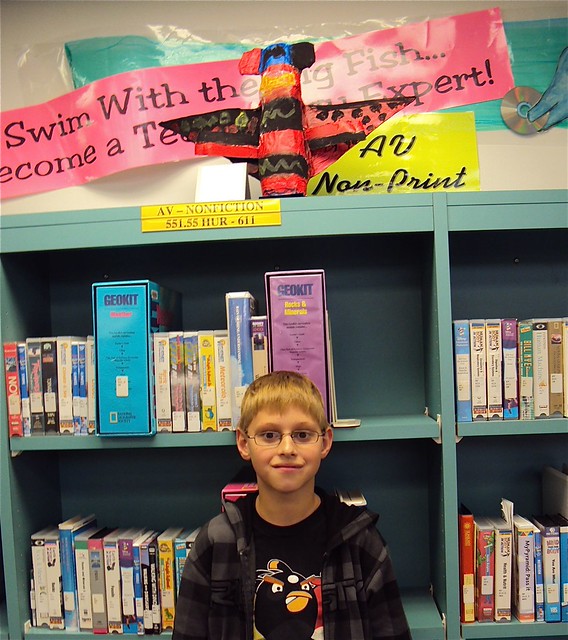
Resources & Links:
Past Related Posts:
Makerspace Starter Kit
Questions About Coloring & Makerspace
The Way of the Lego
The Zen of Coloring
Spot it! Gamification For The Win
10 Coloring Pages for Women’s History Month
More Maker Posts!
Create an Amazing Low-tech Library Makerspace With These Easy Ideas
A Librarian’s Guide to Makerspaces: 16 Resources
Academic Ways to Use the MaKey-MaKey in the Classroom
Make Makey Official Website Lots of great stuff here!
Makey Makey – Makerspace for Education
Top 5 Lessons for Integrating Makey Makey Into Your Curriculum
Sphero Mini – the awesome App-Enabled Robotic Ball review
Classroom Doodles: FREE kid friendly coloring pages!
The Zen of Coloring: 7 Lessons on Living a Happy, Mindful Life
Flexible Classrooms: Research Is Scarce, But Promising
The Seven Myths Keeping Teachers from Designing Makerspaces by @spencerideas
Recycled Media – Julia Sanderl
Create an Amazing Low-tech Library Makerspace With These Easy Ideas
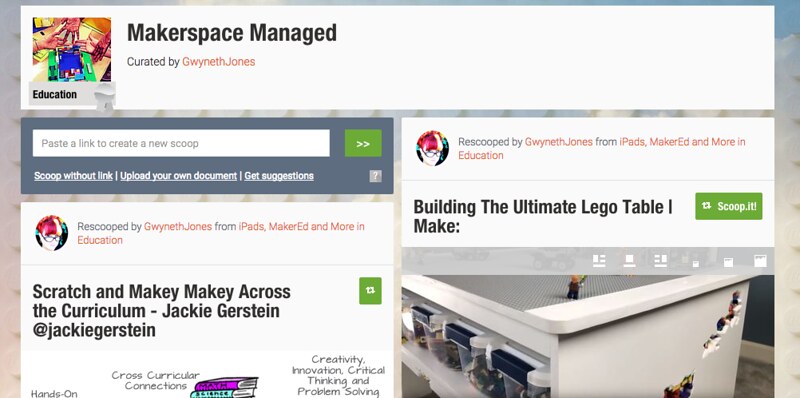
Makerspace Managed Scoopit Page (inspired by Harry Potter & Mischief Managed, naturally!)
Makerspace Managed Pinterest Board
Embedded below:
Intro to Makerspaces in the School Library – a Haiku Deck by @heidinelt
Makerspaces – Created with Haiku Deck, presentation software that inspires;
Your turn!
What do you think? What did I forget? Please leave a comment with your thoughts and I may add it to the post! Thank you & Cheers dears!
Twitter: @GwynethJones – IG: The Daring Librarian. Future Ready Teacher Librarian & Tech Leader. Mover, Shaker, Blogger, International Ed Tech Keynote Speaker, Blogger, & Google Certified. ISTE Board of Directors PK-12 Representative 2010-2014 – Creator of Content. Meme & Trope Archivist Geek. Ridiculously Humble. My beach blog: The Coastal Cottage DE
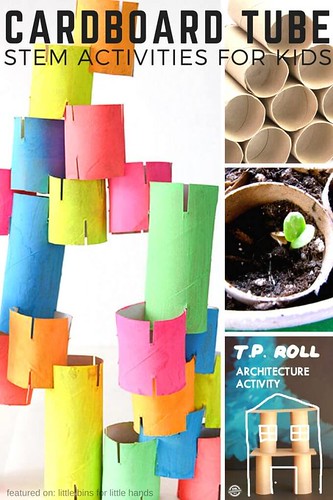
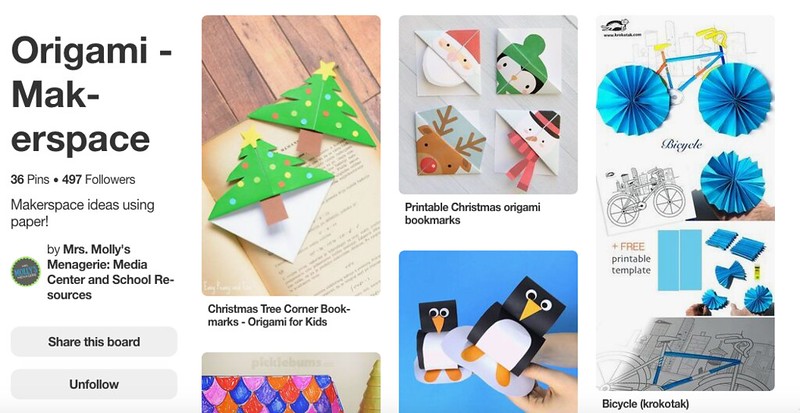
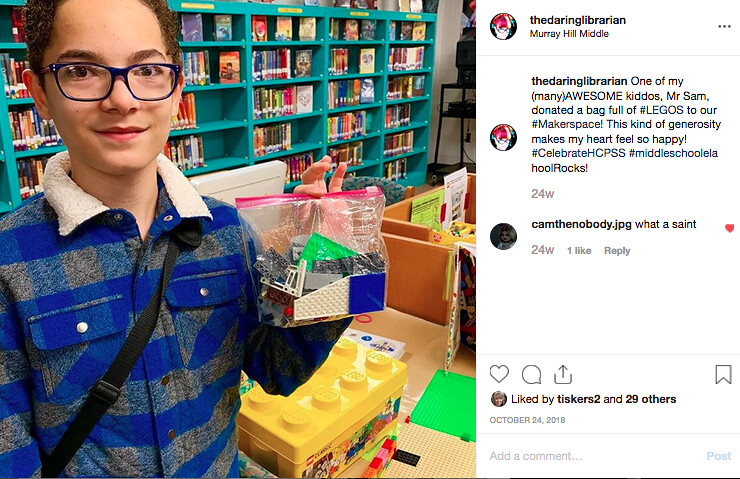




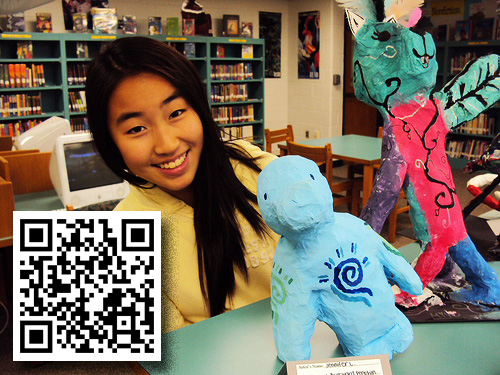
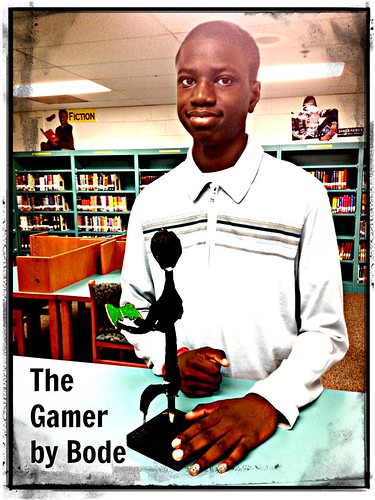
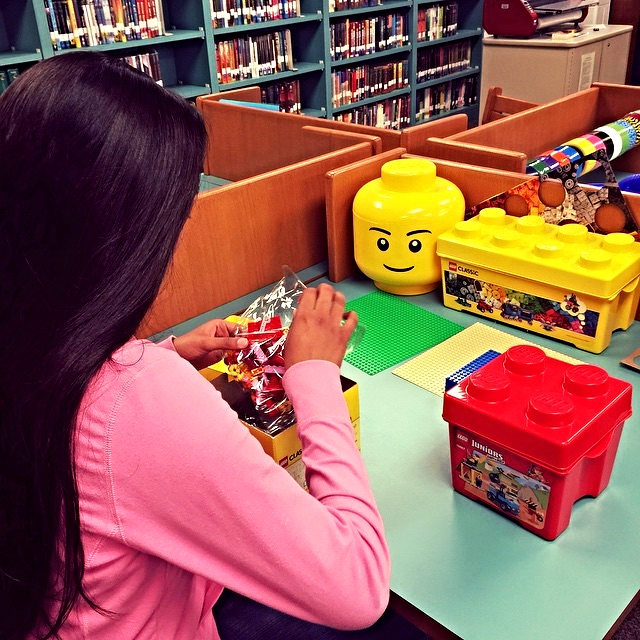
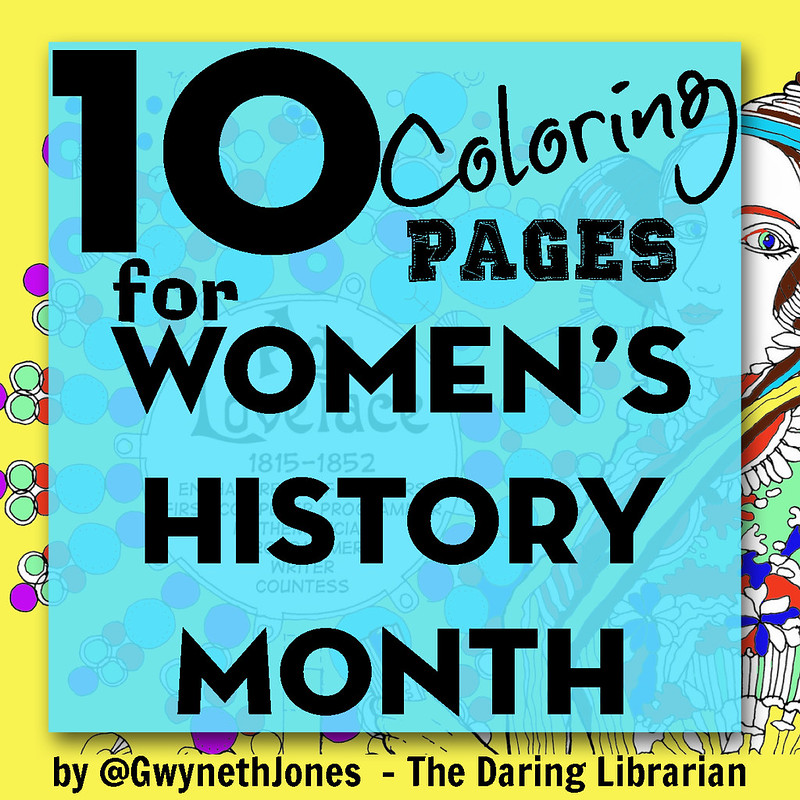


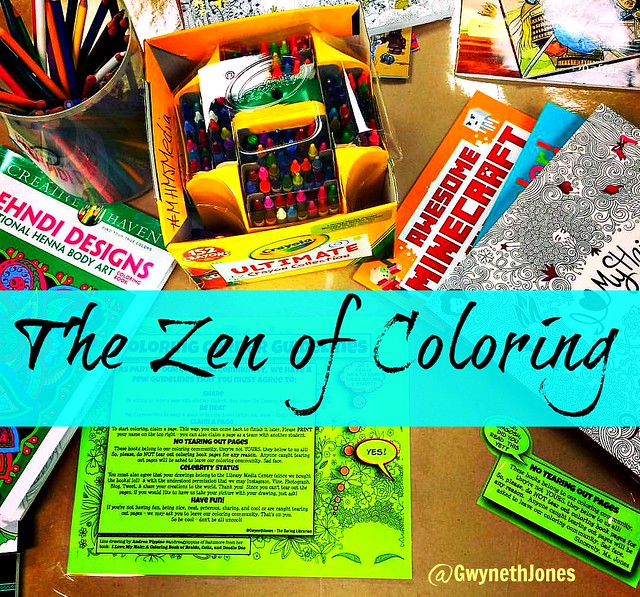

 all the rage, I was a bit skeptical. Then I saw the beautiful new coloring books with loopy, fabulous, mesmerizing line drawings and I was sold! I also just like the smell of a new box of Crayons!
all the rage, I was a bit skeptical. Then I saw the beautiful new coloring books with loopy, fabulous, mesmerizing line drawings and I was sold! I also just like the smell of a new box of Crayons!
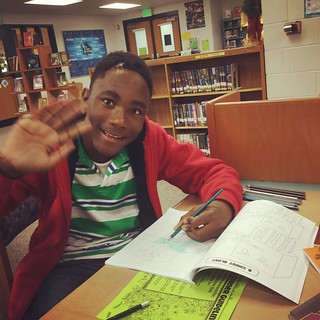


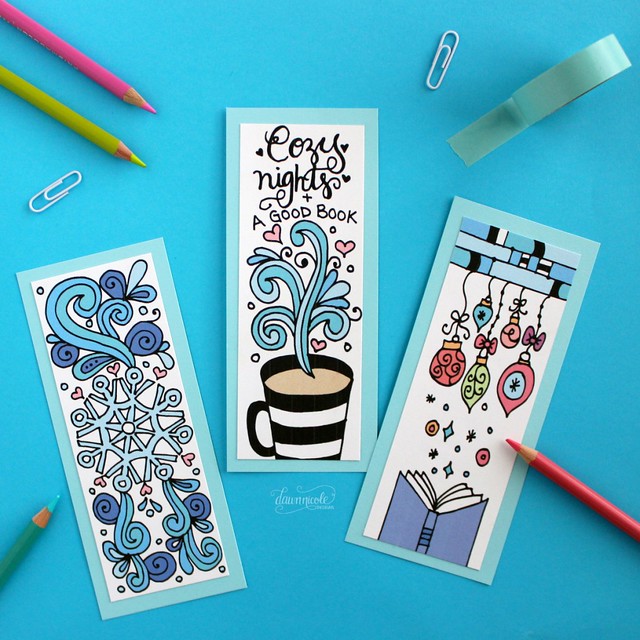
 offer some similar benefits, as William Brennan wrote in this magazine
offer some similar benefits, as William Brennan wrote in this magazine 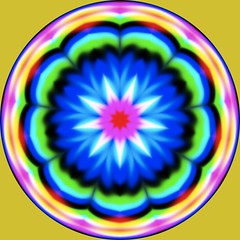
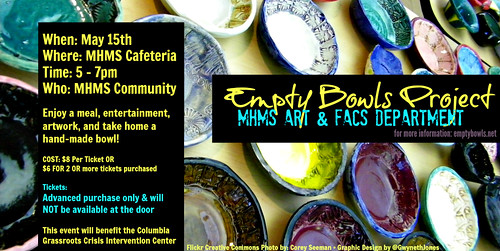
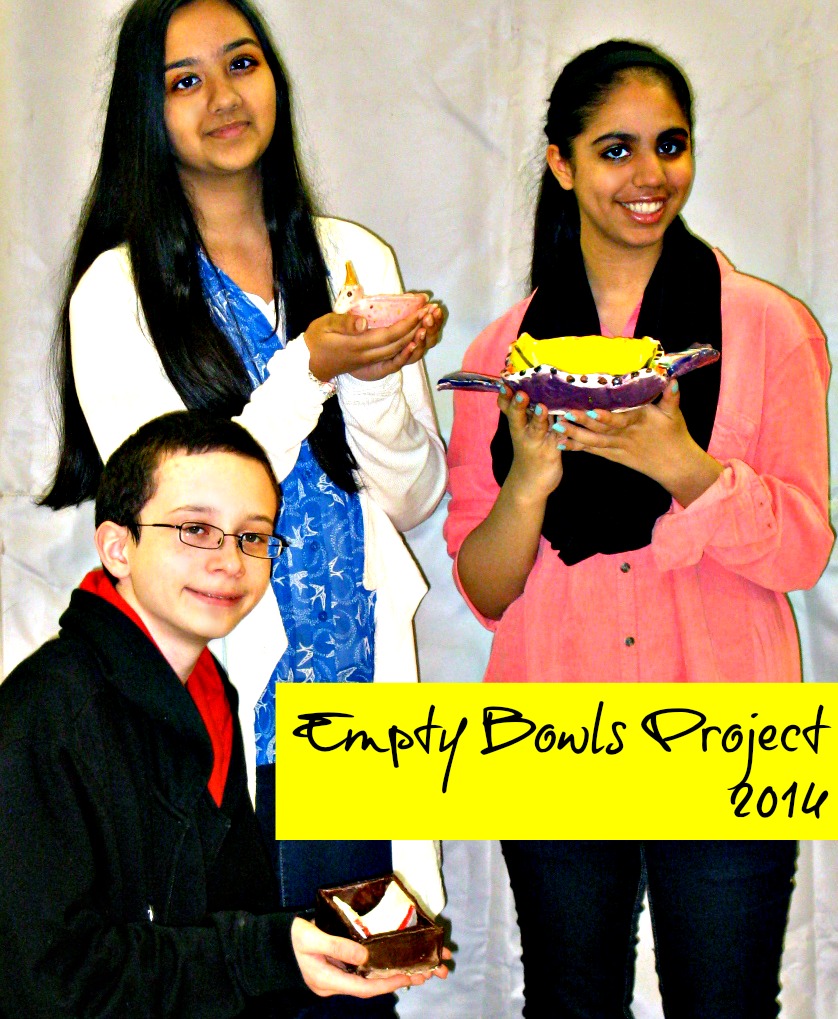
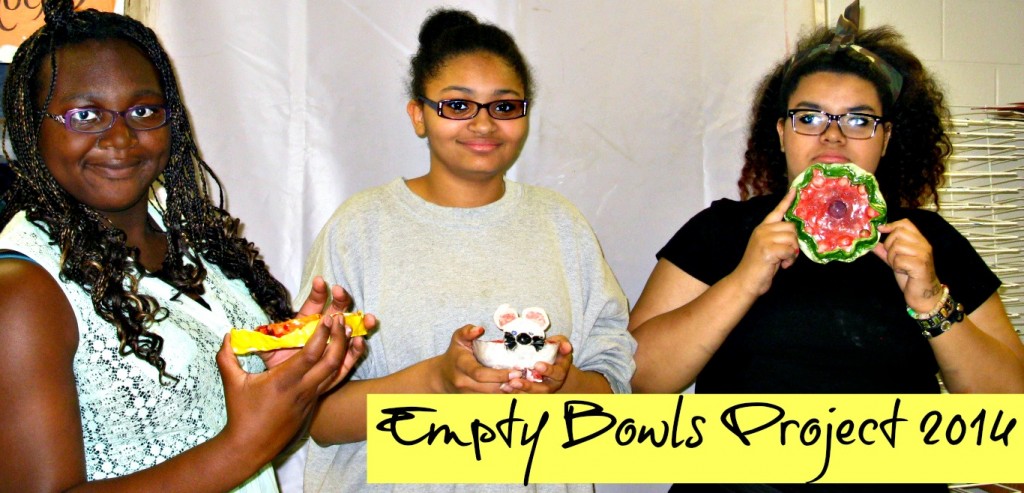
 students researched alebrije sculptures that were originally created by Pedro Linares Lopez, a Mexican artist. Alebrije sculptures show imaginative, hybrid creatures made of parts of different animals. Students brainstormed animal symbols that represented their personalities (example: quiet like a mouse) and combined these creatures together to create an original alebrije-inspired creature.
students researched alebrije sculptures that were originally created by Pedro Linares Lopez, a Mexican artist. Alebrije sculptures show imaginative, hybrid creatures made of parts of different animals. Students brainstormed animal symbols that represented their personalities (example: quiet like a mouse) and combined these creatures together to create an original alebrije-inspired creature.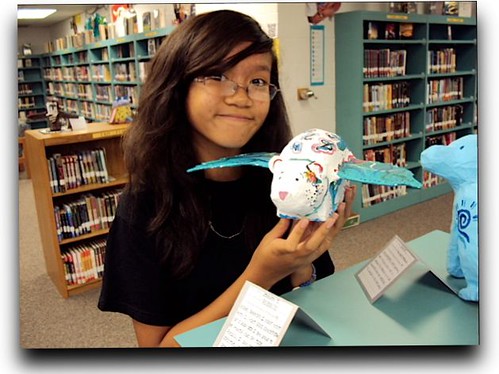 History:
History: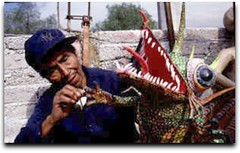 How did Pedro make alebrijes sculptures? When Linares could get out of bed, he started to remember his dream and he wanted his family and everybody to know about the animals he saw, so he used paper, reeds, and wire to create armatures for the alebrijes. Pedro covered the armatures using the paper mache technique. Sheets of plain brown paper or newspaper were added in layers to cover the frame until it was firm. The figure then had to dry thoroughly. In Mexico, the sunny weather speeds up this process. The final figure was first painted white. Then colorful painting and intricate patterns were added. He painted them as he saw them in his dream.
How did Pedro make alebrijes sculptures? When Linares could get out of bed, he started to remember his dream and he wanted his family and everybody to know about the animals he saw, so he used paper, reeds, and wire to create armatures for the alebrijes. Pedro covered the armatures using the paper mache technique. Sheets of plain brown paper or newspaper were added in layers to cover the frame until it was firm. The figure then had to dry thoroughly. In Mexico, the sunny weather speeds up this process. The final figure was first painted white. Then colorful painting and intricate patterns were added. He painted them as he saw them in his dream.